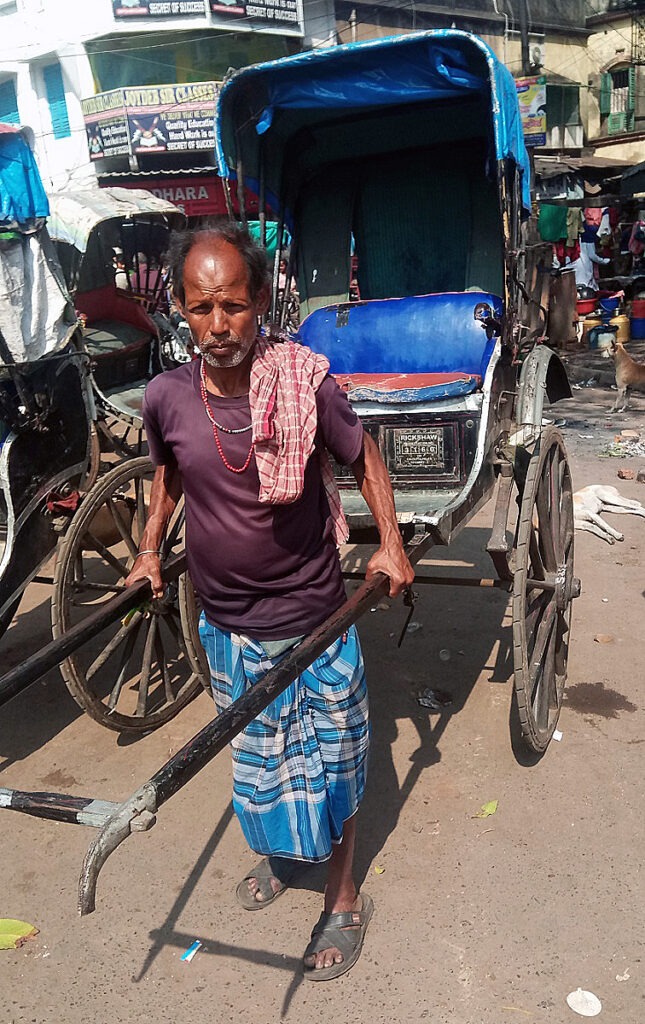INDIA. Kolkata, West Bengal. In the city, it’s common to see a two-wheeled, light-weight mobile device pulled by a barefoot man who often doesn’t look quite up to the task. Wrapped in a lungi from the waist to the knee, at times without a shirt, this skinny man runs through the narrow lanes of Kolkata carrying people sitting in his rickshaw.
A rickshaw is one of the cheapest, non-polluting means of travel for short distances that Kolkattans use. They also have an interesting colonial touch.
Their origin has historical roots. Hand-Pulled Rickshaws date back to the British era. It is believed that the rickshaw was introduced by Chinese Traders around 1900, primarily to carry goods. The word ‘rickshaw’ is derived from the Japanese word ‘jin-riki-sha’, which means a human-powered carriage.
They became something of a cultural icon in the city and have been a means for more affluent Kolkatans to travel since it’s inception, which is when the rich used to ride in palanquins.
The lifeline of the city. Rickshaws are part of the lifeblood of Kolkata. Serving as more than just a tourist amenity, they are an essential service to deliver goods from one place to another. They carry children to and from school and bring women to markets through the incredibly narrow lanes of the city.
It´s difficult for residents to navigate the narrow lanes. It´s an even greater challenge for cars to maneuver, but these men pulling their rickshaws help people get around the city faster and easier. Also during the monsoon, when it ´s more difficult for cars and buses to drive due to waterlogging, they are a welcome form of transport. They keep passengers above the water while the drivers trudge through the flooded streets.
A day in the life of a rickshaw puller. A group of 25 to 30 rickshaw pullers, also known as wallahs, live together in a community setting called a dera. Mr. Badri Mahato came to the City of Joy from Bihar and told Transcontinental Times about his routine and other issues the pullers face on a normal day. He also discussed the added difficulties during COVID-19.

Mahato said, “Pulling a rickshaw is not simple, it’s not a piece of cake. There are a lot of mechanisms involved. We are daily wage earners and during these times, most of us are surviving on the food grains supplied by the government as it’s impossible to get a rider these days”.
Mahato became emotional when saying, “If people don’t ride in our rickshaw, how we will earn our daily bread and butter and send money back home?”
He added, “As long as there are trams on the streets of Kolkata, Mamata Banerjee is the chief minister, and people eat Britannia biscuit, no one can stop hand-pulled rickshaws.” He went on to add that during monsoons, when all of Kolkata is flooded, even the chief minister takes a rickshaw to the office.
Who are the men behind the rides? During the post-independence era of India, hand-pulled rickshaw became the livelihood for Bihari and Odishan immigrants. It also provided an income for Bangladeshi immigrants during and after the 1971 Liberation War.
The present-day pullers are the third or fourth generation, carrying the colonial heritage along with their passengers. The average puller earns between 250-500 rupees a day, out of which they pay 50 rupees for the rickshaw rental and an occasional 100 or more to pay off a policeman. A 2003 study published in National Geographic revealed that rickshaw wallahs are near the bottom of Kolkata occupations in income, faring better than only the ragpickers and the beggars.
Driving into an uncertain future. In 2006, the Marxist government of West Bengal amended the 1919 Hackney Carriage Act of the British era, which allowed passengers to ride rickshaws, thereby officially banning the hand-pulled rickshaws of Kolkata. The government said there was no place in the world today for what they called “human horses.” The mayor of Kolkata also described the job as despicable and inhuman. At the time the chief minister of the state, a Marxist, also called it barbaric. The modern-day generation also finds it offensive to see a man sweating to pull someone for 18 hours a day in the heat and the rain, for just a few rupees.
Subsequently, they are becoming a rare sight. By some counts, the number of hand-pulled rickshaws in the city today is less than five hundred. Only thirty years ago, this number was in the thousands.

